Physical Address
304 North Cardinal St.
Dorchester Center, MA 02124
Gestational trophoblastic disease encompasses a diverse group of trophoblastic proliferations that can be divided primarily into molar and nonmolar lesions. Molar lesions derive from villous trophoblast and include partial (PHM), complete (CHM), and invasive hydatidiform moles. Nonmolar lesions include placental-site nodule (PSN), epithelioid trophoblastic tumor (ETT), placental-site trophoblastic tumor (PSTT), and choriocarcinoma. They can be nonneoplastic (PSN) or neoplastic (ETT, PSTT and choriocarcinoma) and encompass proliferations of trophoblast not accompanied by chorionic villi. Correct classification of these different entities is important, as each is characterized by distinctive clinicopathologic features and clinical management. Moreover, nontrophoblastic tumors can morphologically mimic nonmolar trophoblastic lesions. This chapter will cover the salient morphologic, immunohistochemical, and molecular features that help distinguish between these entities.
A hydatidiform mole , either partial or complete, represents an abnormally developed placenta with distinctive gross, histologic, immunohistochemical, and cytogenetic features caused by excess of paternally derived chromosomal content. It has been shown that paternal DNA plays a significant role in the development of placental tissues and that an excess of paternal DNA leads to overgrowth of trophoblast, whereas maternal DNA contributes more to fetal development.
The overall incidence of hydatidiform moles has decreased remarkably in recent years. In the United States and developed countries, hydatidiform moles are rarely encountered and a true incidence nowadays is difficult to obtain in either CHM or PHM. The best estimation of molar pregnancy is approximately less than 1 in 2000 pregnancies. Earlier literature has indicated that the incidence is decreased with the improvement of the social economic status of a region or a country. Multigravidity (more than four pregnancies) and increased number of abortions are considered to be high-risk factors for the development of a molar pregnancy.
This type of molar gestational disorder is caused by fertilization of an ovum devoid of maternal chromosomal DNA by either two spermatozoids or one spermatozoid with subsequent duplication of its chromosomal DNA. The resulting genotype is two sets of 23 chromosomes, both of paternal origin (diandric diploidy) . Rarely, complete moles have a tetraploid genotype. An invasive hydatidiform mole is defined by the presence of molar villi with associated trophoblastic cells in the myometrium with or without invasion into adjacent structures or at distant sites; this phenomenon is more likely to occur with CHM.
Molar pregnancies occur more frequently in women at the beginning and toward the end of child-bearing age, with the highest incidence over 40 years. With routine use of ultrasound to monitor pregnancy, patients with CHM present more frequently at 12 weeks of gestation or earlier (first trimester) with abnormal ultrasound findings and/or scant bleeding (believed to be a spontaneous abortion). After the 12th week of gestation (second trimester), women present with a constellation of clinical findings. They manifest symptoms such as more abundant vaginal bleeding or occasional passage of molar vesicles. There is uterine enlargement exceeding the size expected for the gestational age and absence of fetal heart sounds. Urine and serum β-human chorionic gonadotropin (β-hCG) levels are markedly elevated (>1,000,000 mIU/mL) at the time of diagnosis, and approximately 10% of patients have related symptoms, including severe hyperemesis, toxemia in early pregnancy, or hyperthyroidism. Patients may also present with ovarian enlargement secondary to multiple theca lutein cysts (hyperreactio luteinalis). Rarely, patients first come to clinical attention with vaginal or lung metastases.
Patients with invasive hydatidiform mole usually present with persistent vaginal bleeding, uterine subinvolution, or asymmetric uterine enlargement. Rarely, perforation or severe intraperitoneal or vaginal hemorrhage may occur.
In a classical CHM (second trimester), ultrasound often discloses a uterus that is enlarged for gestational age and filled with multiple small, hypoechoic areas 3–10 mm in diameter, typically described as “bunch-of-grapes” or “snowstorm” appearance. Transvaginal ultrasound with color Doppler demonstrates lack of vascularity within the mass. No fetal parts or fetal heart rate are identified. In early CHM (first trimester), the aforementioned features are subtle.
The sonographic appearance in an invasive mole includes moderate uterine enlargement with focal increased echogenicity within the myometrium. Computed tomography scan and magnetic resonance imaging (MRI) are useful in detecting myometrial invasion, parametrial extension, and metastases. A chest X-ray can identify early pulmonary metastases, as well as providing a baseline for comparison should pulmonary disease ensue.
The cardinal features of a classic CHM at the second trimester, which is rarely encountered nowadays, include an increased amount of tissue and generalized villous edema resulting in grape-like, transparent vesicles measuring up to 1–2 cm across ( Fig. 19.1A ). In florid cases, the uterus is enlarged and filled with vesicles that may protrude through the cervical os ( Fig. 19.1B ). The vesicles obtained in curettage typically maintain their configuration ( Fig. 19.1C ) but on occasion may be difficult to identify due to partial or extensive collapse. In contrast, an early CHM may show no recognizable gross abnormalities. Typically, no fetus or gestational sac is identified, although in rare cases, evidence of fetal development has been reported.
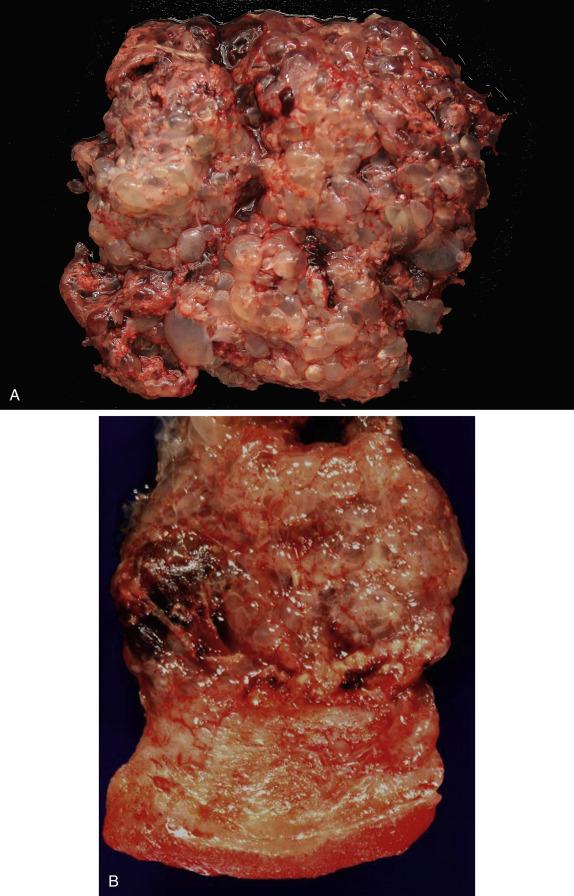
An invasive mole typically appears as an area of hemorrhage or multiple vesicles in the myometrium or, if florid, as hemorrhagic cavities deeply and extensively invading the myometrial wall ( Fig. 19.2 ). The diagnosis of invasive mole can only be made in a hysterectomy specimen.
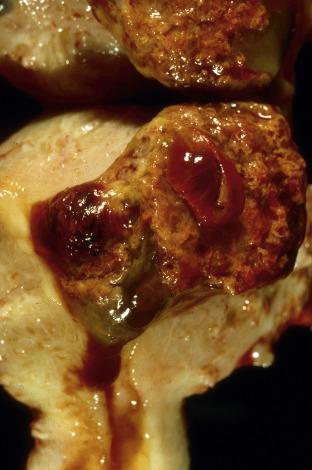
In classic CHM, abnormally formed chorionic villi show generalized hydropic change (cystic swelling) associated with exuberant villous trophoblastic hyperplasia ( Fig. 19.3A ). The edematous villi may contain central cisterns, which are acellular, fluid-filled spaces sharply demarcated from the surrounding villous stroma. The proliferation of the cytotrophoblast and syncytiotrophoblast is circumferential around the enlarged villi ( Fig. 19.3A ), which is in marked contrast to the orderly polarized growth of trophoblast from the end of the anchoring villi in normal and nonmolar gestations ( Fig. 19.3B ). There is also hyperplasia of the intervillous intermediate trophoblast ( Fig. 19.4 ) and the implantation-site intermediate trophoblast, the latter frequently associated with an exaggerated placental site. The hyperplastic villous and nonvillous trophoblastic cells often show considerable cytologic atypia and mitoses may be noted.
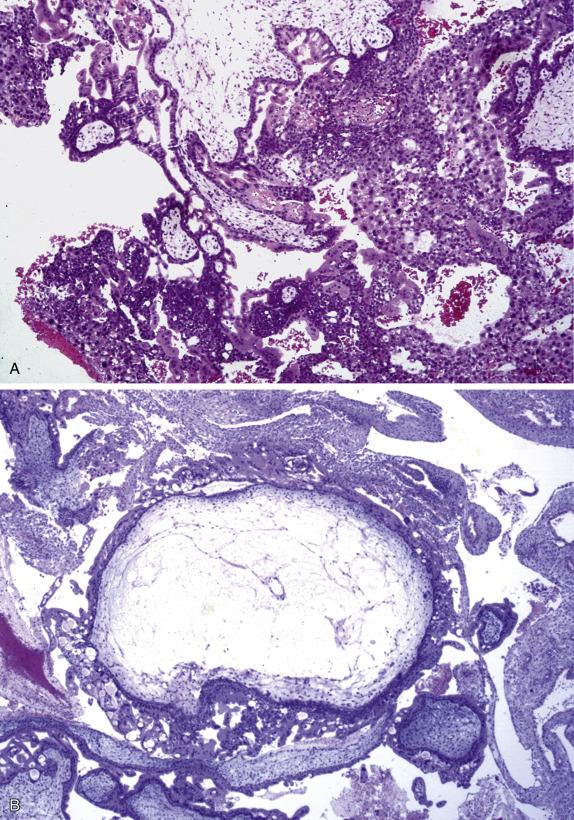
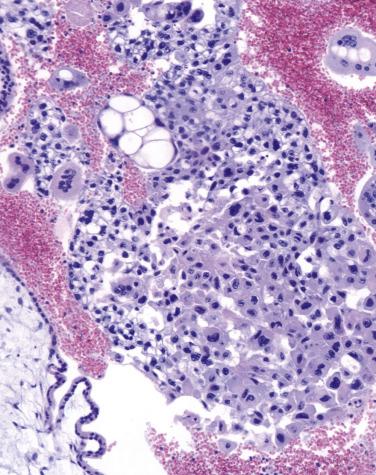
The typical morphologic features of a classic CHM may be absent or very subtle in molar specimens evacuated during first-trimester pregnancies. These early complete moles, which are increasingly more common than the full-blown second trimester ones, are characterized by the following histologic features: (1) redundant bulbous “club-shaped” terminal villi, (2) hypercellular villous stroma with primitive stellate cells in a myxoid background with associated karyorrhexis, (3) a labyrinthine network of villous stromal canaliculi but absence of patent capillaries and fetal blood elements, (4) focal hyperplasia of cytotrophoblast and syncytiotrophoblast on both villi and the under surface of the chorionic plate, and (5) relatively atypical trophoblast in the implantation site ( Fig. 19.5 ). Thus, any villous tissue with abnormal bulbous tips, karyorrhectic stroma, degenerating “empty” stromal vessels, absence of nucleated red blood cells, or somewhat increased amount of villous tissue (typically 3 × 3 × 0.5 cm in a normal first-trimester loss) in a perimenopausal woman should be scrutinized for the diagnosis of early CHM.
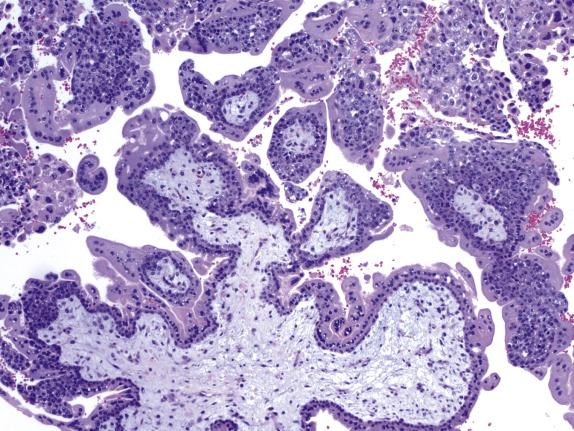
An invasive hydatidiform mole is characterized by invasion of the myometrium or its vascular spaces by molar villi (typically CHM) with proliferating cytotrophoblast and syncytiotrophoblast interfacing directly with the myometrium without intervening decidua.
The immunohistochemical phenotype of hydatidiform moles is similar to that of normal placenta with distinctive expression patterns in different trophoblastic cell types. Cytotrophoblast is typically positive for keratins and CD10 and negative for β-hCG, inhibin, and human placental lactogen (hPL), whereas syncytiotrophoblast cells are strongly positive for β-hCG, placental lactogen alkaline phosphatase (PLAP), inhibin, and CD10, and weakly positive for hPL. p57 is a paternally imprinted, maternally expressed gene; as CHMs are androgenetic in origin and lack maternal DNA content, they show absence of p57 expression in villous stroma and cytotrophoblast. Due to unknown mechanisms, p57 expression is retained in the syncytiotrophoblast and extravillous trophoblast, which can serve as a positive internal control.
CHMs are typically diploid with a 46 XX karyotype (as a result of haploid genome duplication of the content of a single sperm within an empty ovum). A CHM with 46 XY or (less commonly) 46 XX karyotypes is the result of two spermatozoids fertilizing an empty ovum. In any case, this chromosomal composition is known as androgenetic , implying that the genetic material is exclusively derived from paternal DNA, in contrast to the biparental chromosomal composition of normal pregnancies and PHM. The diploid status of CHM can be detected by karyotype, flow cytometry, or in situ hybridization analysis. Polymerase chain reaction–based DNA genotyping is increasingly used as a more specific tool to determine the genotype of molar gestations. In the case of a diploid pregnancy, genotype can determine if the diploidy is biparental (normal gestation) or androgenetic (CHM). Of note, genotype has an excellent correlation with p57 expression, and absence of villous p57 staining is usually considered sufficient to confirm the diagnosis of CHM. Exceptions to this rule include retained maternal copies of chromosome 6 and 11 with secondary aberrant p57 expression, twin gestation with one CHM and one normal twin, and cases of placental mosaicism.
Spontaneous abortions are often associated with failure of embryonic development or early embryonic demise, so-called blighted ovum or hydropic abortus. The volume of tissue obtained in a hydropic abortus is typically much less than in a molar placenta. On microscopic examination, the villi are only slightly enlarged/edematous without true cisternae, and the trophoblast lacks hyperplasia and atypia. Trophoblast proliferation is confined to the trophoblastic columns that face the basal plate at the distal end of the villous and is polar instead of concentric. Immunohistochemistry for p57 will aid in challenging cases and should be considered especially in patients with clinical concern for molar pregnancy. Genotyping, if accessible, can also offer a definitive diagnosis. Ploidy analysis is not useful in the differential of CHM versus normal placenta, as both have a diploid DNA chromosomal content.
Although the trophoblastic hyperplasia and atypia of a CHM in isolation resemble the biphasic growth of choriocarcinoma , the presence of chorionic villi excludes this diagnosis. An exception to this rule is intraplacental choriocarcinoma, which arises in otherwise normal -appearing placentas during the third trimester, at which point the diagnosis of molar pregnancy is not a consideration. Another consideration is choriocarcinoma as a complication of CHM. In this setting, the diagnosis of gestational choriocarcinoma requires evidence of destructive infiltrative growth in addition to the absence of chorionic villi 8–12 weeks after the evacuation of a confirmed hydatidiform mole.
The differential diagnosis between CHM and partial hydatidiform mole (PHM) is based primarily on histologic features. However, an early CHM may be difficult to distinguish from PHM, and a twin placenta with one normal placenta and a CHM may be misinterpreted as a PHM because of the finding of two populations of villi. p57 can be useful in this setting as nuclear p57 expression is absent in cytotrophoblast and stromal cells in CHM, which differs from the diffuse staining seen in PHM and nonmolar placentas.
The most serious complications of a molar pregnancy include persistent gestational trophoblastic disease and choriocarcinoma. Persistent gestational trophoblastic disease is a clinical term describing a plateau or continual rise of serum β-hCG levels following pregnancy (usually molar). It may be associated with extrauterine trophoblastic disease. Pathologically, persistent gestational trophoblastic disease corresponds to a persistent mole with no invasion, an invasive mole, or choriocarcinoma. Persistent gestational trophoblastic disease occurs in approximately 17%–20% of women who have undergone evacuation and in 3%–5% of women who have undergone hysterectomy for the treatment of CHM. The risk of developing choriocarcinoma following a CHM is approximately 2%–5% in the United States.
The primary treatment of CHM is early and complete evacuation; however, recent studies have shown that early evacuation does not necessarily affect outcome. Likewise, the primary treatment of an invasive mole is surgical (hysterectomy). Oral contraception and monitoring of serum β-hCG levels after surgical removal of CHM or invasive mole are required. Patients are followed for 6–12 months or until serum β-hCG level falls to normal levels. If serum β-hCG levels do not normalize, the diagnosis of persistent trophoblastic disease is rendered and chemotherapy is initiated. Modern chemotherapy has led to a cure rate approaching 100% in persistent trophoblastic disease.
This type of molar gestational disorder is caused by fertilization of an ovum with a normal set of maternal chromosomal DNA by either two spermatozoids or one spermatozoid with subsequent duplication of its chromosomal DNA. The resulting genotype is three sets of 23 chromosomes, one of maternal origin and two of paternal origin (diandric triploidy) .
Patients with PHM usually present with abnormal uterine bleeding at the end of the first trimester that is clinically interpreted as a spontaneous or missed abortion. The uterus is typically normal or small in size for gestational age, and fetal heart sounds may be present. Urine and serum β-hCG levels are either normal or much lower than those observed in CHM. Toxemia of pregnancy may also occur, but much less frequently than with CHM.
diploidy (two paternal haploid sets of DNA and no maternally derived DNA)
1 in 1000 to 1 in 2000 pregnancies
CHM represents >50% of molar gestations
Patients usually <20 years or >40 years old, with highest incidence >40 years
Early complete mole (<12 weeks of gestation):
Scant bleeding, more commonly incidental
Classic complete mole (12–25 weeks of gestation):
Vaginal bleeding or passage of molar vesicles
Excessive uterine enlargement for expected gestational age
Absence of fetal tissue or heart sounds
Earlier onset of toxemia
Markedly elevated serum β-hCG levels
“Snowstorm” appearance, lack of vascularity within villi, and no fetal parts
Early and complete evacuation
Monitor serum β-hCG levels for 6–12 months or until normal
Chemotherapy if β-hCG levels do not normalize
Overall almost 100% survival rate
Persistent gestational trophoblastic disease in 3%–20%
Progression to choriocarcinoma in 2%–5%
Uniformly large, grape-like, transparent vesicles (if classic)
Typically no fetus or gestational sac
Generalized hydropic change in villi with central cisterns
Marked circumferential hyperplasia of villous cytotrophoblast and syncytiotrophoblast
Hyperplasia of intervillous and implantation site trophoblast
Striking cytologic trophoblast atypia (villous and extravillous)
Absent fetal tissues
Bulbous “club-shaped” terminal villi
Hypercellular myxoid villous stroma with karyorrhexis
Labyrinthine network of villous stromal canaliculi
Absence of patent capillaries and fetal blood (nucleated red blood cells)
Less exuberant, often noncircumferential hyperplasia of cytotrophoblast and syncytiotrophoblast
Absence of p57 nuclear staining in villous trophoblast and stromal cells (staining in decidua and extravillous trophoblast acts as positive internal control)
Karyotype, flow cytometry, and in situ hybridization: Diploidy (usually 46 XX)
Genotyping: diandric diploidy (two sets of paternal origin)
Hydropic abortion
Choriocarcinoma
Partial hydatidiform mole
Transvaginal ultrasound shows only focal abnormalities, typically irregularity of chorionic villi with scattered enlarged and cystic (grape-like) forms. Villous blood vessels and embryonic or fetal tissues can be observed.
The amount of tissue obtained is typically less abundant than in a CHM (<200 mL) ( Fig. 19.6A ) but may be more than that obtained in a conventional abortion ( Fig. 19.6B ). Grossly, large vesicles are less striking than in a CHM and admixed with nonmolar placental tissue ( Fig. 19.6A ). A fetus is more commonly associated with a PHM, frequently showing developmental abnormalities, particularly syndactyly.
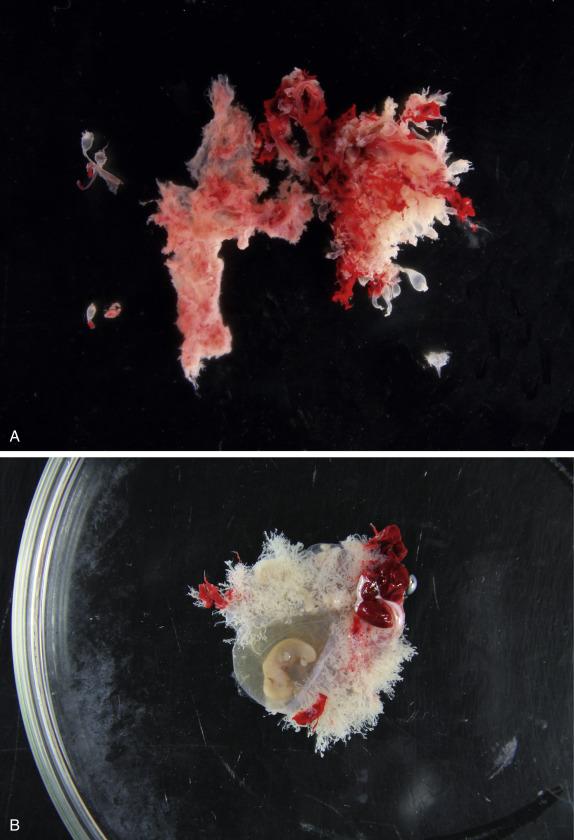
The hallmark of PHM is the presence of a heterogeneous population of chorionic villi with variation in villous sizes and shapes. Typically, this heterogeneity is seen as two morphologically discrete but admixed populations of chorionic villi: one large and edematous and the other normal-sized ( Fig. 19.7 ). The enlarged villi show irregular, scalloped outlines and may contain “trophoblast inclusions” as a result of tangentially sectioned infoldings of the surface trophoblast into the villous stroma. At least some of the hydropic villi show a central, acellular cistern as seen in CHM. Trophoblastic hyperplasia is limited to the syncytiotrophoblast cells. They form slender projections emanating from the villous surface, frequently with prominent cytoplasmic lacunar development, resulting in a “lacy” or “moth-eaten” appearance ( Fig. 19.8 ). Nucleated red blood cells may be seen in the villous capillaries. Other histologic evidence of embryonic/fetal development includes chorionic plate, amnion, umbilical cord, and embryonic/fetal tissues.
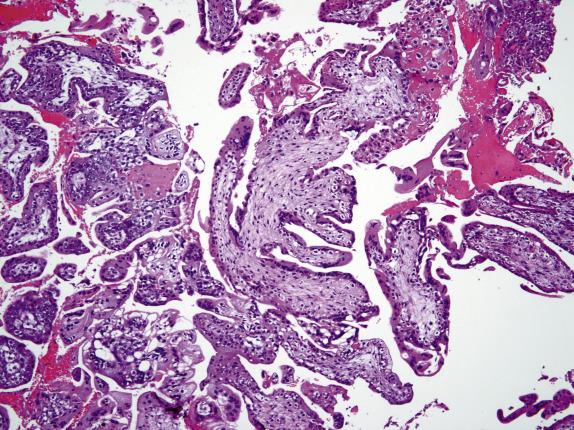
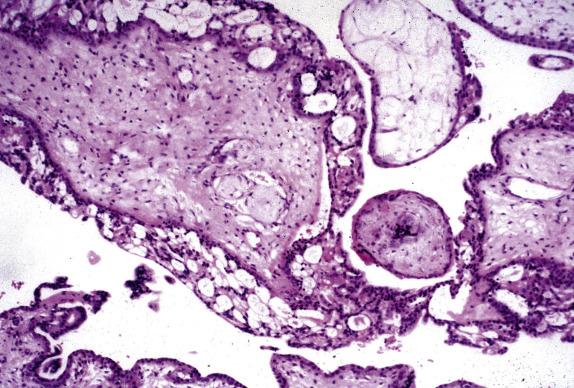
Since PHM has a maternal copy of the p57 gene (not imprinted), nuclear expression of p57 by immunohistochemistry is retained in villous stroma and cytotrophoblast.
Ploidy studies (karyotype, flow cytometry, and in situ hybridization) reveal triploidy, usually 69 XXX or XXY (rarely XYY). Genotyping is necessary to determine the paternal versus maternal composition of the DNA content, which is diandric in PHM (two sets of paternal and one set of maternal chromosomal DNA).
PHM may mimic a CHM , particularly during the first trimester and in the rare instance of a twin placenta with one normal placenta and a CHM. On morphologic grounds, a biphasic/heterogeneous profile of villous sizes and the presence of nucleated red blood cells and other embryonic tissues are more in keeping with PHM. Staining for p57 is most helpful in this distinction, as CHM will show absence of staining in villous stroma and cytotrophoblast (globally in singleton CHM; admixed positively and negatively stained villi in a twin CHM-normal gestation).
PHM requires distinction from a normal gestation with hydropic change and nonmolar aneuploidy gestations . Distinction is important because management of these conditions does not require continued contraception as it does for molar pregnancy; furthermore, these abnormalities are not associated with an increased risk of developing gestational trophoblastic disease. Nonmolar chromosomal abnormalities may include autosomal trisomies, monosomy X, and some other genetic syndromes (Beckwith–Wiedemann syndrome), which may display hydropic changes, stromal villous karyorrhexis, and abnormal villous morphology mimicking a PHM. PHM usually displays at least three of the following histologic features: two discrete populations of villi, syncitiotrophoblastic hyperplasia that may be circumferential, trophoblastic inclusions, prominent villous contour irregularity and scalloping of villi, and cistern formation. In contrast, nonmolar aneuploid gestations display at most two of these features ( Fig. 19.9 ). Chromosomal content (ploidy) analysis by karyotype, flow cytometry, and/or fluorescence in situ hybridization can be contemplated, since it can confirm nonmolar causes of aneuploidy (trisomies 21, 13, and 18, and monosomies 16 and X being the most frequent) and triploidy (in keeping with PHM). An important caveat is the rare instance of a triploid nonmolar pregnancy. A triploid gestation with two complete maternal sets of genes is associated with a fetus with intrauterine growth retardation, dysmorphic features, and a small placenta, a clinical picture quite different from that of PHM. However, in an evacuation specimen during first trimester, there may be histologic overlap with PHM. If ploidy analysis reveals a triploid result, genotyping may be required to establish the diagnosis (diandric triploid result in PHM, digynic triploid result in nonmolar triploidy). If ancillary cytogenetic or molecular testing is not available or feasible in a case with ambiguous features, the diagnosis of products of conception with dysmorphic features , followed by a note in the pathology report recommending the monitoring of serum β-hCG levels, is advisable.
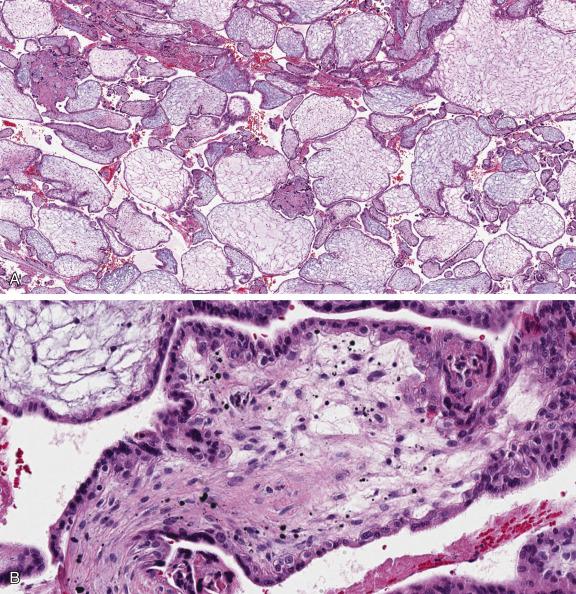
Placental mesenchymal dysplasia is a rare and still poorly understood disorder of the placenta. In one-third of cases, the fetus exhibits Beckwith–Wiedemann Syndrome. It is characterized by massive hydrops of stem villi with cystic dilation, vesicle formation, placentomegaly, and abnormally thick vessels with fibromuscular hypertrophy ( Fig. 19.10A ,B). In contrast to the changes in the stem villi, terminal villi appear normal, which results in a heterogeneous or biphasic appearance resembling PHM. Unlike PHM, in placental mesenchymal dysplasia the β-hCG levels remain within normal limits throughout pregnancy, and the fetus has a normal karyotype. Moreover, there is no trophoblastic hyperplasia or atypia. Distinction is mainly morphologic. Some cases of placental mesenchymal dysplasia have a particular p57 expression profile with retained staining in cytotrophoblast but loss in the villous stroma ( Fig. 19.11 ). Unlike PHM, placental and fetal tissues in the context of placental mesenchymal dysplasia have a diploid chromosomal content. Interestingly, placental mesenchymal dysplasia associated with Beckwith–Wiedemann syndrome shows androgenetic and biparental mosaicism, with a predilection of androgenetic cells in the placenta and biparental cells in the fetus.
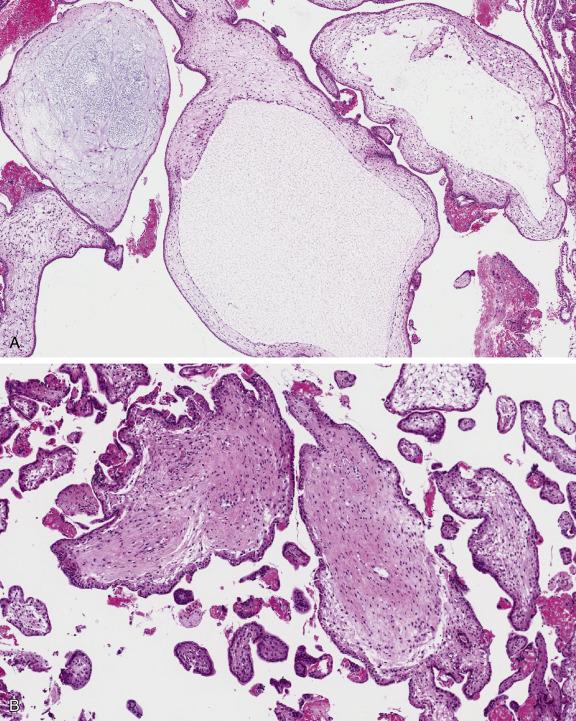
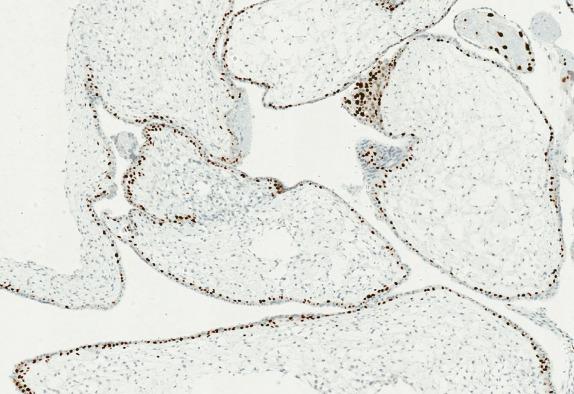
In contrast to CHM, a diagnosis of PHM is rarely followed by persistent or metastatic gestational trophoblastic disease, with risk estimates of less than 1%. Likewise, the risk of progression to choriocarcinoma is very low (<1%). Management includes primary evacuation of uterine contents followed by oral contraception and monitoring of β-hCG levels for a period of at least 6 months.
A summary of the key distinguishing features is presented in Table 19.1 .
Gestation with diandric triploidy (two paternal and one maternal haploid sets of DNA)
25%–43% of molar gestations
Patients usually <20 or >40 years old, with highest incidence >40 years
Become a Clinical Tree membership for Full access and enjoy Unlimited articles
If you are a member. Log in here